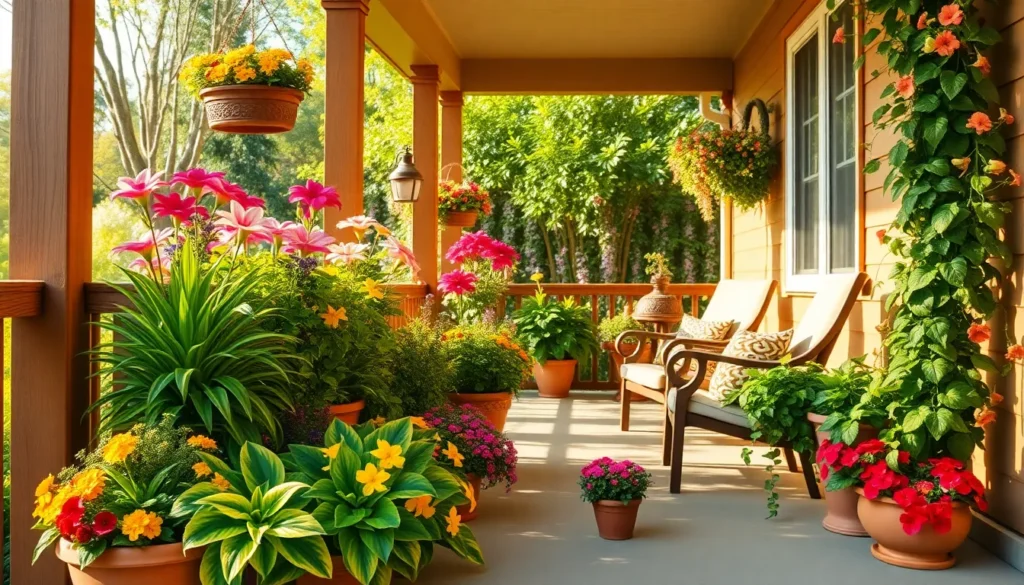Transform your front porch into a welcoming oasis that instantly boosts your home’s curb appeal and creates a warm first impression for every visitor. The right plants can turn an ordinary entrance into a stunning focal point that reflects your personal style while adding natural beauty to your outdoor space.
We’ve discovered that selecting the perfect front porch plants doesn’t have to be overwhelming or expensive. Whether you’re dealing with full sun blazing down all day or a shaded area that barely sees direct light there are countless options that’ll thrive in your exact conditions. From vibrant flowering displays to lush greenery that stays beautiful year-round the possibilities are endless.
Ready to create the front porch of your dreams? We’ll guide you through the best plant choices that combine stunning visual impact with low-maintenance care so you can enjoy a gorgeous entrance without the stress of constant upkeep.
Choose Low-Maintenance Perennials for Year-Round Appeal
Perennials offer the perfect solution for busy homeowners who want lasting beauty without constant replanting. These hardy plants return year after year and require minimal care once established.
Hostas for Shaded Front Porches
Hostas thrive in partial to full shade conditions that challenge many other plants. We’ve found these leafy perennials create stunning focal points with their varied foliage patterns including solid greens, yellows, and striking variegated combinations. Popular varieties like ‘Sum and Substance’, ‘Patriot’, and ‘Blue Angel’ provide different sizes and colors to suit any porch design.
Water requirements stay minimal once hostas establish their root systems in spring. These plants naturally die back in winter and emerge fresh each spring with larger clumps than the previous year. Slugs can occasionally damage leaves but copper barriers or organic slug baits solve this issue quickly.
Daylilies for Sunny Exposures
Daylilies flourish in full sun locations where other perennials struggle during hot summer months. Each bloom lasts only one day but plants produce dozens of flower buds throughout their blooming season from late spring through fall. Colors range from classic yellows and oranges to deep purples, pinks, and near-white varieties like ‘Stella de Oro’ and ‘Happy Returns’.
Drought tolerance makes daylilies ideal for porches that receive direct sunlight most of the day. We recommend dividing clumps every 3-4 years to maintain vigorous blooming and prevent overcrowding. Deadheading spent blooms encourages continued flowering but isn’t essential for plant health.
Ornamental Grasses for Texture and Movement
Ornamental grasses add ever-changing visual interest that changes with weather conditions and seasons. Fountain grass, feather reed grass, and Japanese forest grass create gentle motion that softens hard porch surfaces like concrete or stone. These grasses provide year-round structure since many varieties maintain their form through winter months.
Most ornamental grasses require cutting back only once per year in late winter or early spring. We’ve observed these plants handle both drought and occasional flooding better than traditional flowering perennials. Deer rarely browse ornamental grasses making them perfect for rural or suburban front porches where wildlife visits frequently.
Select Seasonal Annuals for Continuous Color
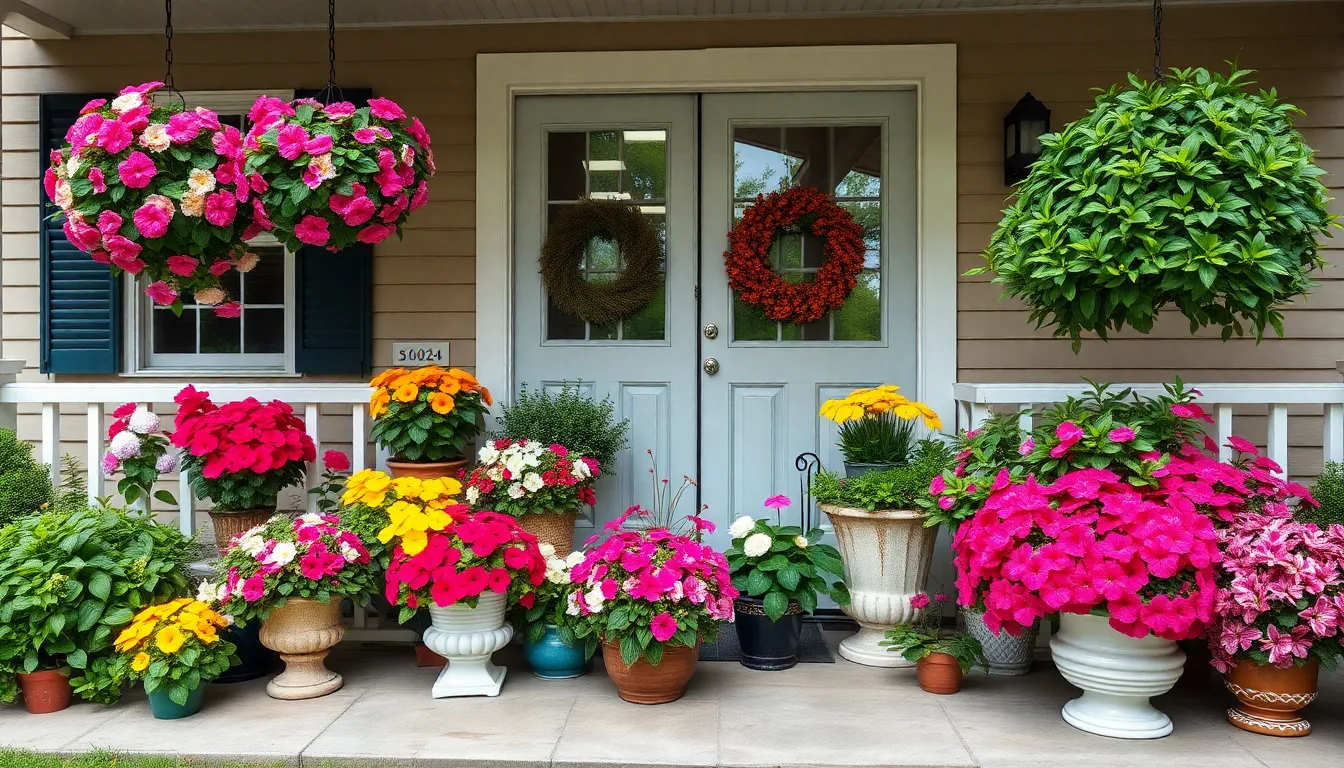
While perennials provide lasting structure, seasonal annuals deliver bursts of vibrant color that transform your front porch throughout the year. We’ll guide you through the top annual choices that ensure continuous blooms and maximum visual impact.
Petunias for Vibrant Summer Blooms
Petunias dominate sunny front porches with their explosive summer color display that lasts from late spring through frost. These versatile annuals thrive in full sun conditions and adapt beautifully to containers, window boxes, and hanging baskets. Their trailing growth habit creates stunning cascading effects that add vertical dimension to your porch design.
Regular deadheading keeps petunias producing fresh blooms continuously throughout the growing season. Water them consistently but avoid overwatering, as petunias prefer slightly dry conditions between waterings. Their heat tolerance makes them perfect for south facing porches that receive intense afternoon sun.
Choose from grandiflora varieties for large, showy blooms or multiflora types for abundant smaller flowers that better withstand rain and wind. Wave petunias offer exceptional spreading habits that create dramatic spills from elevated planters.
Pansies for Cool-Weather Display
Pansies excel during fall and early spring months when temperatures remain moderate and other annuals struggle. These hardy flowers perform best when daytime temperatures stay between 45-65°F, making them ideal transition plants between seasons. Their cheerful faces brighten porches during cooler periods when color options become limited.
Plant pansies in areas receiving partial sun or filtered shade, especially during warmer parts of their growing season. They tolerate light frost and often continue blooming even after snow melts. Their compact growth habit works perfectly in containers and window boxes where you want precise color placement.
Combine pansies with cool season herbs like parsley or ornamental cabbage to create layered displays that offer both beauty and functionality. Replace them with summer annuals once temperatures consistently reach the 70s.
Impatiens for Consistent Flowering
Impatiens provide reliable color for shaded porch areas where sun loving annuals fail to thrive. These shade champions produce continuous blooms in locations receiving partial to full shade throughout the growing season. Their low maintenance requirements make them perfect for busy homeowners who want beautiful results without extensive care.
Water impatiens regularly to maintain consistent soil moisture, as they wilt quickly when stressed by drought. Their succulent stems and leaves indicate when they need water by becoming soft and droopy. Recovery happens rapidly once you restore proper moisture levels.
New Guinea impatiens offer larger flowers and more colorful foliage than traditional varieties, while standard impatiens provide classic appeal with abundant small blooms. Both types flourish in containers and maintain their shape without requiring deadheading or pruning.
Incorporate Evergreen Shrubs for Structure and Privacy

While seasonal annuals bring bursts of color throughout the year, evergreen shrubs provide the essential backbone that keeps your front porch looking polished and inviting during every season. These permanent plantings create privacy screens, define boundaries, and maintain visual interest when flowering plants enter dormancy.
Boxwood for Classic Formal Appeal
Boxwood (Buxus spp.) remains the gold standard for creating sophisticated front porch landscapes with its dense, small-leafed evergreen foliage. We love how this traditional choice adapts beautifully to shaping, making it perfect for neat hedges, elegant topiaries, or structured borders that frame your porch entrance.
Dense foliage creates natural privacy screens while maintaining that coveted formal appearance that enhances curb appeal. Once established, boxwood requires minimal maintenance, making it an ideal choice for busy homeowners who want maximum impact with minimal effort. The compact growth habit works exceptionally well in containers or as foundation plantings directly in the ground.
Juniper Varieties for Different Shapes and Sizes
Junipers offer incredible versatility with their diverse range of forms, from low-growing ground covers to upright shrubs and small trees. Their needle-like evergreen foliage displays beautiful blue-green or gray-green colors, with some varieties producing attractive berries that add seasonal interest.
This diversity allows us to customize porch screens or create stunning accent plants according to your exact space and style preferences. Hardy and drought-tolerant characteristics make junipers exceptionally low-maintenance options that thrive in varying porch conditions. Whether you need a tall privacy screen or a low border planting, there’s a juniper variety that fits perfectly.
Rhododendrons for Spring Flowering
Rhododendrons deliver the best of both worlds as evergreen shrubs that burst into spectacular spring blooms while maintaining beautiful dark green foliage throughout the year. Large, showy flowers create dramatic seasonal color displays that transform your porch into a stunning focal point.
These shrubs thrive in partial shade conditions and prefer acidic soil, making them excellent foundation plants near covered porches. We recommend positioning them where you’ll enjoy both their magnificent spring flower show and their year-round evergreen structure. Their substantial size and presence make them perfect for anchoring corner plantings or creating natural privacy barriers.
Add Container Plants for Flexibility and Style
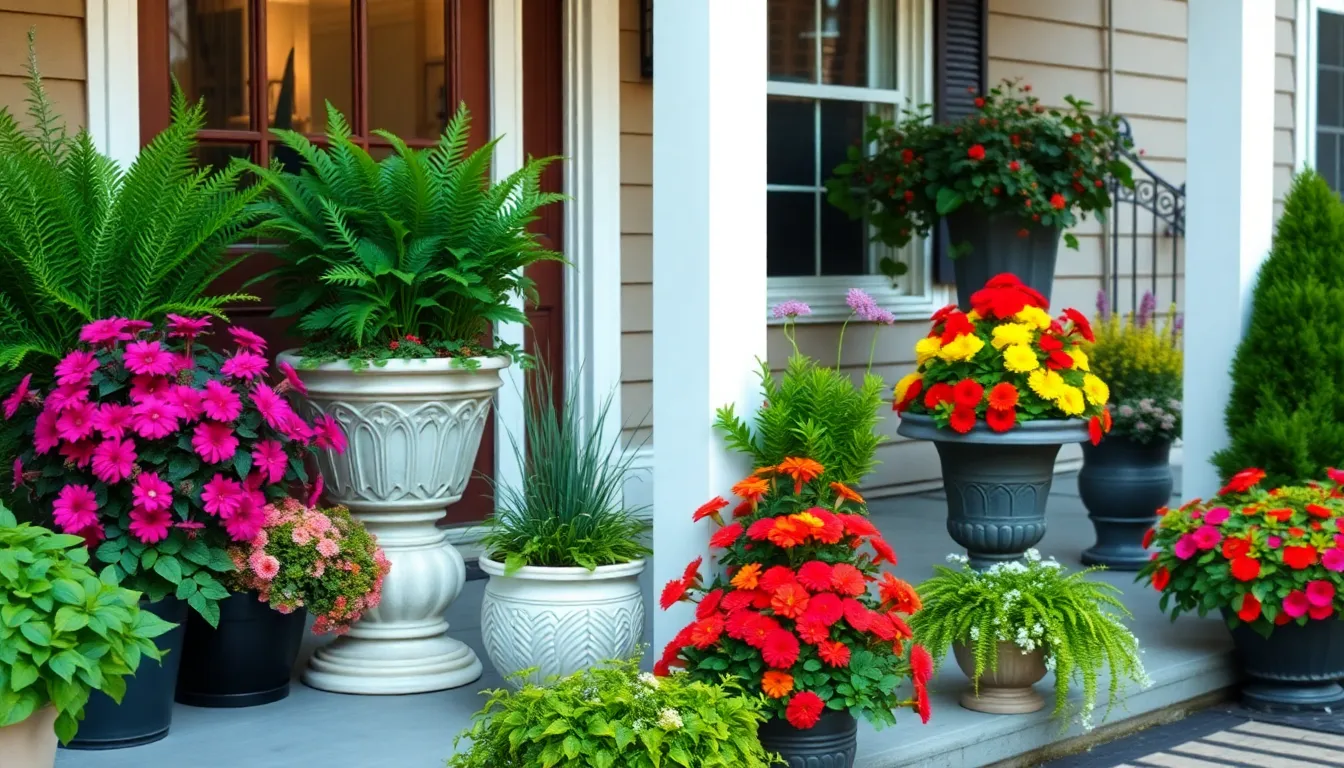
Container plants offer endless possibilities for customizing your front porch design while accommodating varying light conditions and seasonal changes. We can easily rearrange these portable gardens to create fresh looks throughout the year.
Potted Ferns for Instant Greenery
Boston ferns create lush, natural beauty on shaded or part-shade porches with their cascading fronds and rich green texture. These classic container plants require moderate watering and thrive without direct sunlight, making them perfect for covered areas. We love how ferns provide textural contrast when paired with flowering plants, adding depth and dimension to our porch displays. Their instant greenery effect transforms any space into a welcoming outdoor retreat.
Herb Gardens in Decorative Planters
Rosemary stands out as our top choice for sunny front porches, growing 4-6 feet tall while producing fragrant flowers that create stunning focal points. This hardy perennial thrives alongside other Mediterranean herbs like sage, thyme, and oregano in decorative containers. We appreciate the dual purpose these herb gardens serve, providing fresh ingredients for our kitchens while adding ornamental beauty to our porches. During colder months, we can bring these containers indoors to extend our harvest season.
Seasonal Container Arrangements
Gomphrena and lantana deliver vibrant summer colors with exceptional heat tolerance, creating long-lasting blooms that withstand intense sun exposure. Fall arrangements featuring chrysanthemums paired with hardy boxwoods maintain visual interest as temperatures drop. We rotate our seasonal containers throughout the year to keep our porches fresh and colorful while adjusting to changing weather conditions. This flexible approach allows us to experiment with different plant combinations and color schemes that match each season’s unique character.
Install Climbing Vines for Vertical Interest

Transform your front porch’s vertical space with climbing vines that add dramatic height and natural beauty. These versatile plants create stunning focal points while maximizing your growing space.
Clematis for Stunning Floral Displays
Clematis delivers spectacular blooms that transform ordinary porch structures into show-stopping displays. We love how this climbing vine produces profuse flowering displays in various colors and shapes, creating dramatic vertical elements that catch every visitor’s eye. The best blooms appear from late spring to early summer when clematis reaches peak performance.
Plant clematis in well-drained soil with proper sunlight exposure for optimal flowering results. Choose from purple, white, pink, or red varieties to match your porch’s color scheme. Support structures like trellises or arbors help clematis climb effectively while showcasing its stunning floral abundance.
Boston Ivy for Natural Coverage
Boston Ivy excels at providing quick, natural coverage for walls, trellises, and porch railings. This fast-growing vine creates lush green foliage during spring and summer months, then transforms into brilliant red and orange displays throughout fall. We recommend Boston Ivy for homeowners seeking both privacy screening and seasonal visual interest.
The vine’s rapid growth covers unsightly areas while adding texture and depth to porch surfaces. Dense foliage creates natural privacy barriers without requiring extensive maintenance once established. Fall color changes provide spectacular autumn displays that enhance your porch’s seasonal appeal.
Honeysuckle for Fragrant Blooms
Honeysuckle brings delightful fragrances and pollinator activity to your front porch environment. This climbing vine produces sweet, pleasant aromas from late spring through summer, creating an inviting atmosphere for outdoor relaxation. We appreciate how honeysuckle attracts hummingbirds and butterflies, adding ever-changing wildlife activity to your porch space.
The fragrant blooms enhance your porch’s ambiance while providing natural pest control through beneficial insect attraction. Choose native honeysuckle varieties to support local ecosystems while enjoying consistent flowering performance. Train honeysuckle along railings or pergolas to maximize fragrance distribution throughout your porch area.
Consider Succulents for Modern Low-Water Gardens
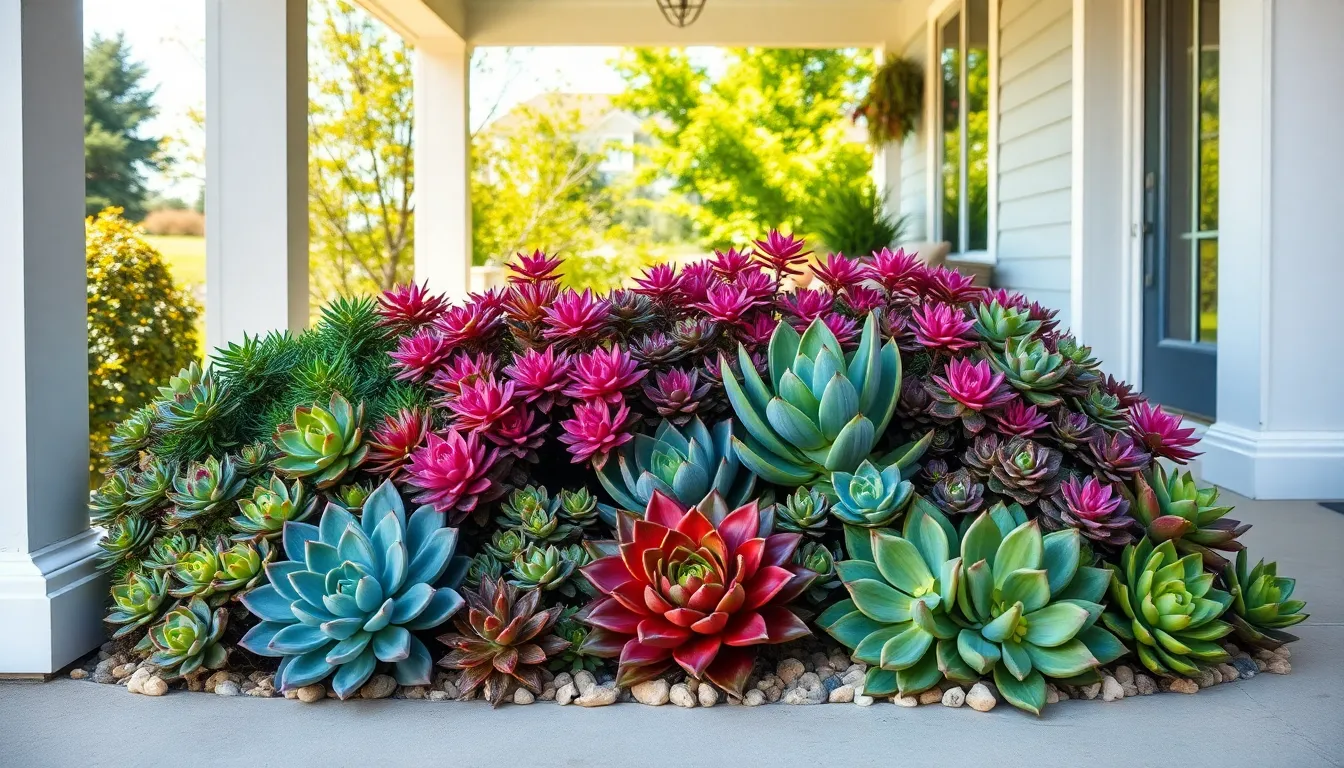
Succulents transform front porches into stunning, water-wise displays that perfectly complement our modern gardening goals. We’ve found these resilient plants thrive in bright sun conditions while requiring minimal watering, making them ideal choices for busy homeowners seeking both beauty and practicality.
Sedums for Colorful Ground Cover
Sedums deliver exceptional ground cover answers with their thick, fleshy leaves and charming star-shaped flowers that bloom throughout the growing season. We love how these hardy succulents spread naturally to fill containers and garden beds, creating dense carpets of texture and color. Popular varieties offer blooms in shades ranging from bright yellow to deep red, while their foliage provides year-round interest in containers on your porch. These versatile plants work beautifully when paired with taller specimens, adding layered visual depth to your front entrance design.
Agave for Dramatic Focal Points
Agave plants create striking architectural statements with their bold, spiky forms that immediately draw attention to your porch entrance. We recommend positioning these sculptural succulents as central focal points where their dramatic silhouettes can shine against softer background plantings. Their thick, pointed leaves form impressive rosettes that can reach substantial sizes, making them perfect for large containers or corner placements. The contrast between agave’s sharp geometry and flowing plant companions creates ever-changing visual tension that elevates your entire porch design.
Echeveria for Rosette Formations
Echeveria succulents bring perfect symmetry to porch displays with their neat, rosette-shaped leaf arrangements that range from soft green to dusty pink and blue-gray tones. We find these compact plants work exceptionally well in shallow containers where their sculptural qualities can be fully appreciated from multiple viewing angles. Their leaves develop beautiful color variations when exposed to bright light, creating natural artwork that requires virtually no maintenance. These charming rosettes multiply naturally, allowing you to expand your collection or share starts with neighbors who admire your low-water porch garden success.
Plan for Different Light Conditions
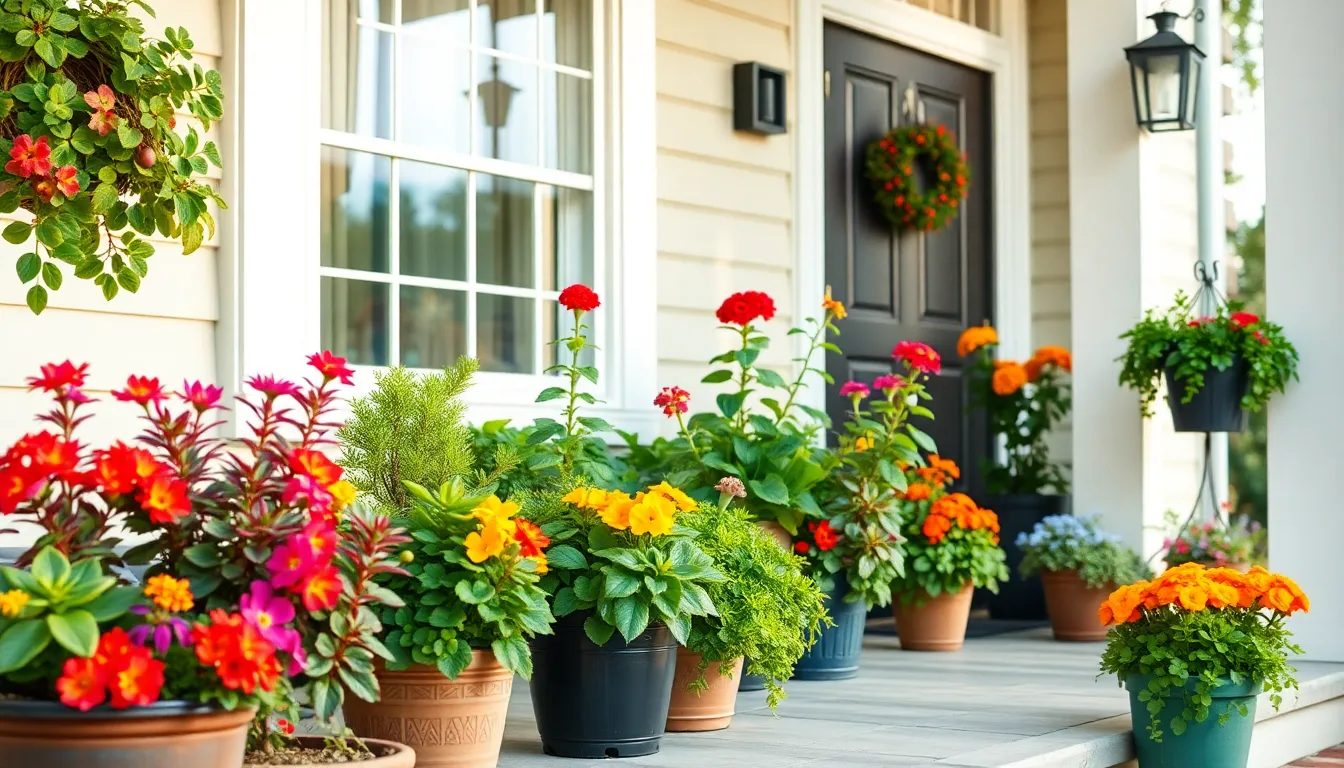
Understanding your porch’s sunlight exposure helps us choose plants that’ll thrive rather than struggle. We’ll explore options for every lighting scenario to ensure your front porch plants flourish.
Full Sun Plant Options
Full sun porches receive 6 or more hours of direct sunlight daily, creating perfect conditions for sun loving species. Succulents and cacti excel in these bright environments, requiring minimal water while providing striking architectural shapes. Lavender transforms sunny spaces with its fragrant purple blooms and silvery foliage that releases aromatic oils in the heat.
Geraniums deliver continuous color throughout the growing season, producing vibrant red, pink, or white flowers that cascade beautifully from containers. Marigolds offer pest deterrent properties while blooming prolifically in golden and orange hues. Petunias create stunning displays with their trumpet shaped flowers, available in countless color combinations and patterns.
Warning signs of insufficient sunlight include yellowing leaves, stunted growth, and sparse flowering patterns that indicate your plants need more direct exposure.
Partial Shade Selections
Partial shade areas receive 3 to 6 hours of sunlight daily, typically enjoying morning light while avoiding harsh afternoon exposure. Begonias thrive in these conditions, producing abundant flowers in shades of pink, red, white, and coral. Impatiens create lush displays of continuous blooms that prefer filtered light over intense sun.
Fuchsias add elegant beauty with their distinctive drooping flowers in purple, pink, and white combinations. Ferns provide textural contrast with their delicate fronds that create cooling green backdrops. Caladiums contribute dramatic foliage in heart shaped leaves featuring striking patterns of pink, red, white, and green.
These selections perform best when they receive gentle morning sunlight followed by afternoon protection from scorching rays.
Deep Shade Tolerant Varieties
Deep shade locations receive less than 3 hours of direct sunlight, requiring plants adapted to low light environments. Snake plants excel in these challenging conditions, featuring upright sword like leaves with yellow edges that tolerate neglect. ZZ plants provide glossy green foliage that maintains its appearance even in dim corners.
Cast iron plants live up to their name by surviving in extremely low light while producing broad, dark green leaves. Hostas create substantial ground coverage with their large leaves in various sizes and colors, from solid green to variegated patterns. Ivy offers cascading greenery that spills gracefully from containers or climbs vertical surfaces.
| Light Condition | Hours of Direct Sun | Best Plant Examples |
|---|---|---|
| Full Sun | 6+ hours | Succulents, Lavender, Geraniums |
| Partial Shade | 3-6 hours | Begonias, Impatiens, Ferns |
| Deep Shade | Less than 3 hours | Snake Plant, ZZ Plant, Hostas |
We recommend observing your porch throughout one full sunny day to accurately determine which category matches your lighting conditions before selecting plants.
Factor in Your Climate Zone and Local Conditions
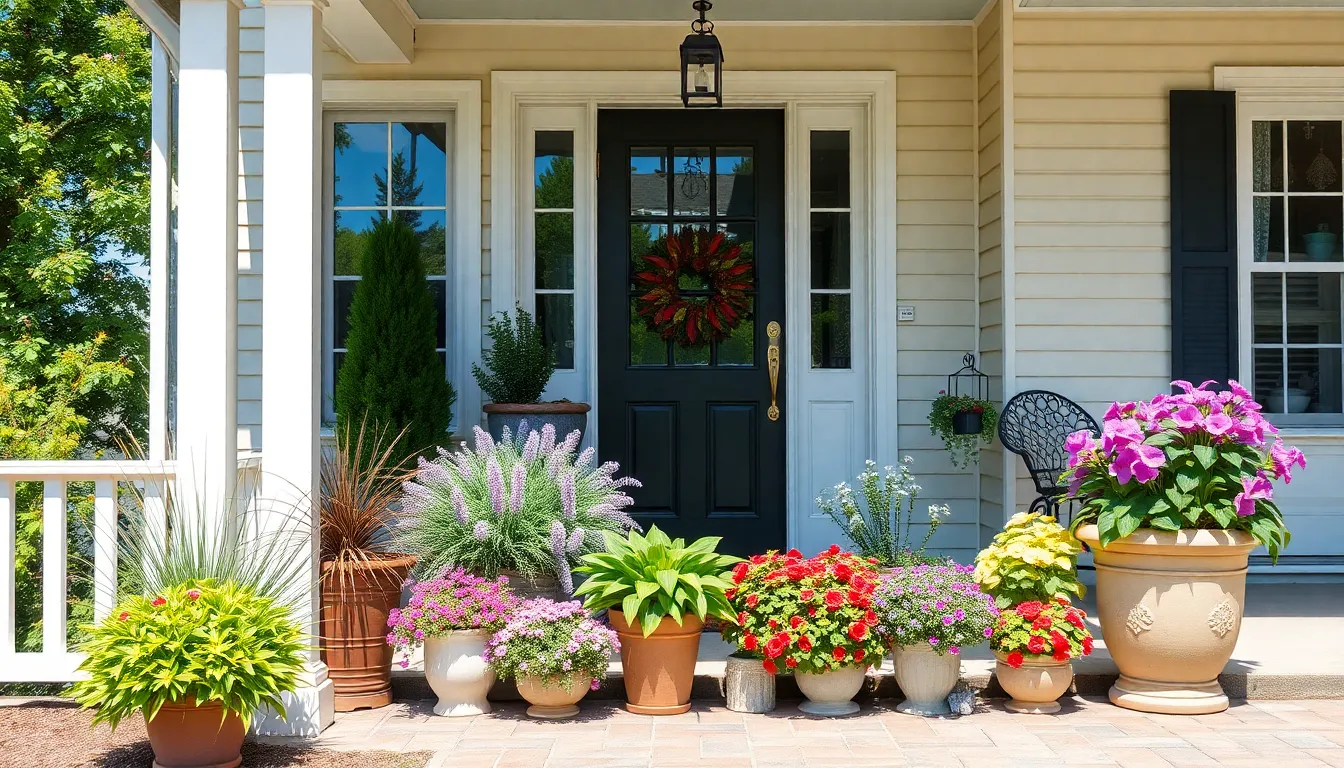
After understanding your porch’s sunlight exposure, we need to consider your regional climate to ensure plant success. The USDA Plant Hardiness Zone Map divides regions from Zone 1 (coldest) to Zone 13 (warmest) based on average minimum winter temperatures, helping us select plants suited to temperature extremes and seasonal changes.
Cold-Hardy Plants for Northern Regions
Cold-hardy plants become essential for USDA Zones 1-5 where freezing temperatures and harsh winter conditions dominate. Boxwood (Buxus) offers excellent structure and withstands severe cold while maintaining its classic evergreen appeal year-round. Ornamental grasses like feather reed grass provide texture and movement, surviving harsh winters and returning reliably each spring.
Evergreen conifers adapted to colder climates create lasting visual impact throughout the winter months. Hardy perennials including Heuchera and Sedum establish robust root systems that survive freezing temperatures and emerge stronger each season. Sheltered front porch areas provide extra protection, potentially allowing us to grow less hardy plants by moderating temperature extremes.
Heat-Tolerant Options for Southern Areas
Heat-tolerant plants thrive in southern USDA Zones 8-13 where intense heat and drought conditions challenge many species. Salvia varieties like ‘Amistad’ deliver continuous blooms while withstanding extreme temperatures and requiring minimal water once established. Wisteria creates stunning coverage for shaded or semi-shaded porches, providing relief from intense afternoon sun.
Succulents and cacti excel in hot, dry conditions, storing water efficiently and adding architectural interest to porch displays. Heat-resistant herbs including rosemary and oregano serve dual purposes, offering culinary value while thriving in challenging southern climates. Providing partial shade and ensuring good airflow help protect plants from the most intense afternoon sun exposure.
Humidity-Resistant Choices
High humidity regions require plants that resist fungal diseases and thrive in moisture-rich environments. Fatshedera, a hybrid specifically bred for humidity tolerance, maintains healthy foliage even in challenging conditions. Certain Salvia cultivars offer natural disease resistance while providing continuous color throughout humid seasons.
Tropical plants adapted to humid environments flourish when porch conditions allow for proper drainage and air circulation. Proper drainage systems and strategic airflow placement around plants reduce humidity-related issues and promote healthy growth. Selecting plants with natural resistance to fungal problems ensures long-term success in moisture-rich climates.
Conclusion
Transforming your front porch with the right plants doesn’t require a green thumb or endless hours of maintenance. We’ve shown you how to create stunning displays that work with your exact conditions – whether you’re dealing with full sun blazing heat or deep shade challenges.
The key lies in matching plants to your environment and choosing varieties that deliver maximum impact with minimal effort. From structural evergreens that provide year-round backbone to colorful annuals that keep things fresh seasonally your porch can become a welcoming focal point.
Remember that successful porch gardening starts with understanding your unique conditions – sunlight exposure climate zone and maintenance preferences. With these fundamentals in place you’re ready to create an inviting entrance that enhances your home’s curb appeal and brings you joy every time you come home.
Frequently Asked Questions
What are the best low-maintenance plants for front porches?
Hostas are excellent for shaded areas, offering diverse foliage patterns with minimal care once established. Daylilies work well in sunny spots, providing drought tolerance and vibrant blooms. Ornamental grasses add texture and movement while requiring little maintenance. These perennials provide year-round appeal without extensive upkeep.
How do I choose plants based on my porch’s sunlight exposure?
Observe your porch throughout a sunny day to determine lighting conditions. Full sun (6+ hours) suits succulents, lavender, and petunias. Partial shade (3-6 hours) works for begonias, impatiens, and ferns. Deep shade (less than 3 hours) is ideal for snake plants, hostas, and ivy.
What seasonal annuals provide continuous color throughout the year?
Petunias thrive in full sun and create stunning cascading effects in containers. Pansies excel in cooler months, providing cheerful blooms even in light frost. Impatiens deliver reliable color in shaded areas with low maintenance needs. These annuals ensure continuous visual impact across seasons.
Which evergreen shrubs work best for front porch structure?
Boxwood offers classic appeal and adaptability, perfect for hedges and topiaries with minimal maintenance. Junipers provide versatility in various forms and colors while being hardy and drought-tolerant. Rhododendrons deliver stunning spring blooms and evergreen foliage, thriving in partial shade conditions.
How can container plants enhance my front porch design?
Container plants offer flexibility and customization options. Boston ferns provide lush greenery for shaded areas. Herb gardens in decorative planters serve both aesthetic and culinary purposes. Seasonal arrangements with summer blooms like lantana or fall displays with chrysanthemums keep your porch fresh year-round.
What climbing vines add vertical interest to front porches?
Clematis provides stunning floral displays and visual appeal. Boston ivy offers natural coverage with beautiful seasonal color changes. Honeysuckle delivers fragrant blooms while attracting beneficial pollinators. These vines enhance privacy and create inviting outdoor spaces with minimal maintenance requirements.
Are succulents good options for front porches?
Yes, succulents are excellent modern, low-water options. Sedums create colorful ground cover in bright sun conditions. Agave plants provide dramatic architectural presence as focal points. Echeveria succulents offer beautiful rosette formations with minimal maintenance, adding symmetry and visual interest to porch displays.
How important is climate zone consideration when selecting porch plants?
Climate zone consideration is crucial for plant success. Use the USDA Plant Hardiness Zone Map to select appropriate plants. Colder regions (Zones 1-5) need cold-hardy plants like boxwood. Warmer areas (Zones 8-13) require heat-tolerant options like salvia and succulents for optimal growth.

